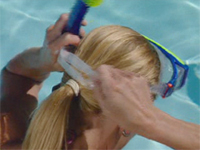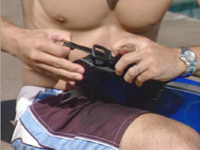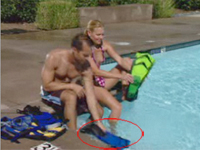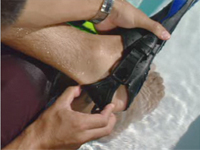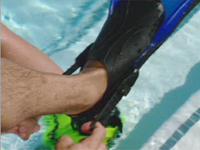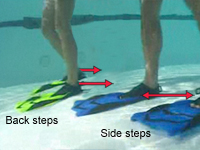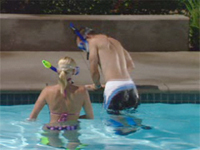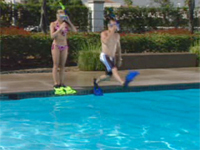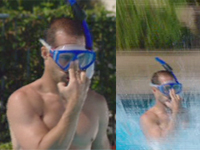|
Setting Up Your Snorkelling Gear
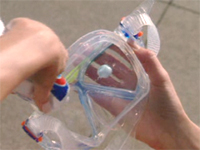 |
Take your new mask and apply a small amount of mild dish soap or toothpaste on the inside of your mask lens before your first use then rinse thoroughly with fresh water. This will remove any manufacturing compound that may case the mask to fog up.
|
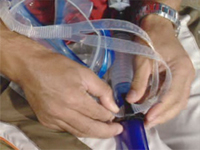 |
Attach the snorkel keeper, the plastic clip on the snorkel, mid-way down the snorkel tube. The snorkel keeper should be positioned on the outside of the mask strap and the left side of the mask (left side when you mask is on your face).
|
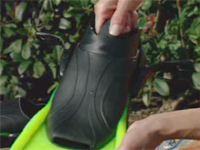 |
Pull the inserts out of the fin's foot pocket. |
Tips For Mask Usage
| You should put some drops of anti-fog solution on the inside of the mask if you have not recently cleaned your mask. If anti-fog solution is unavailable, spit on the inside of the lens and spread it evenly across the glass. Rinse your mask thoroughly when you are finished. This process helps prevent fogging. |
 |
|
Before putting on the mask, loosen straps by depressing buttons on the proglide buckle while pulling on the centre of the mask strap. Repeat process for other side.
Position the mask strap on top of the mask while holding the mask against your face. Slide the strap over your head and pull both of the loose ends of the mask strap until the mask seals comfortably against your face. The strap should lay flat against the back of your head. |
|
| If you are experiencing leakage from your mask check to make sure: Your hair is not caught or stuck between the mask skirt and your face. The mask skirt is lying flushing against your face. The mask straps are adjusted properly. |
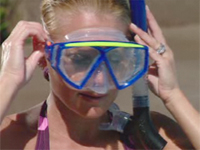 |
Putting On Your Snorkel
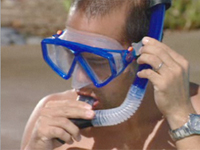 |
The snorkel keeper slides up and down on the tube. Adjust the snorkel on the keeper until the mouthpiece fits comfortably inside your mouth.
The placement of the snorkel should rest in front of your ear on the left side of your head. |
Putting On Your Fins
|
| Care and Maintenance Of Your Snorkelling Equipment |
|
| For best results, always be sure to rinse your gear thoroughly with fresh water after each use. |
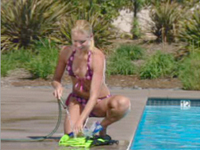 |
|
Allow to air dry and store in a cool place away from the sun. |
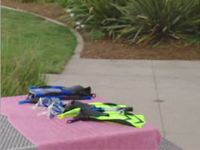 |
|
|
Using Your Snorkelling Equipment |
|
Entering The Water
Clearing Your Snorkel
| When you dive underwater, your snorkel will fill up with water. This is normal.
To remove excess water when you are at the surface, use the "blast" method by exhaling forcefully into the mouthpiece.
This will expel water through the tube and purge. The purge is a one-way valve located at the bottom of the mouthpiece housing.When faced with a flooded snorkel and empty lungs it is best to remain calm and use minimal energy to solve the problem using the breath method. Instead of going vertical and raising your head out of the water, remain horizontal with your face downward. Using your left hand, grasp the snorkel tube at the bend and in a continuous motion turn your head sharply and remove the snorkel from your lips. This clears your mouth at the surface, allowing you to take another breath so that you can use the blast method to clear snorkel. |
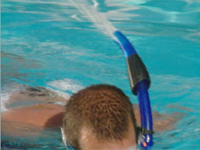 |
Kicking Your Fins
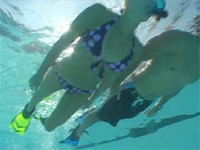 |
The most efficient kick is a relaxed kick starting at the hip. Your knees are slightly bent and your toes are pointed in the opposite direction from where you want to travel. |
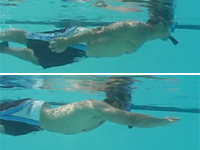 |
Keep your face in the water, arms at your sides or out in front of you and remain as streamlined as possible. Propel yourself with a smooth kick motion and avoid continuing the upstrokes of your kick cycle to the point that your fins break the surface. |
Ear Clearing
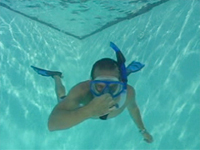 |
When you dive below the surface of the water you will feel pressure in your ears. You can cause damage to your ears if they are not properly equalized. By using air from your lungs you can balance the pressure.
Here is how you equalize: Grasp your nose, seal off your nostrils, and gently blow without allowing any air to escape through your nose or mouth. You should hear a slight popping sound. |
 |
You should equalize every few feet as you descend, however, do not force equalization. Do not descend any deeper than you can clear your ears. |
|
| Guidelines For Snorkelling |
|
* ALWAYS snorkel with a buddy. In the event that you become tired, your buddy can assist you back to shore.
* Do not hold your breath for long dives underwater. Extended breath holding can cause blackouts that can lead to drowning.
* Do not dive deeper than the maximum depth in which you can equalize the pressure in your ears.
* For a greater snorkelling experience, we encourage you to receive instruction from a qualified diving instructor.
* NEVER dive head first into the water, as the lens is not designed to withstand this kind of impact.
* Snorkelling with your head at a 45-degree angle helps to eliminate water entering into the top of your snorkel by keeping a properly mounted snorkel safely above the waterline.
* Always exit the water when you are cold or tired.
* Do not dive below the water surface if you have a head cold. Congestion makes equalizing your ears very difficult.
* Do not use snorkelling equipment as a tool to learn how to swim. Snorkelling is designed for those who can maintain a basic level of swimming.
* If you are snorkelling off a boat, always fly a diver’s flag or something similar to notify area boaters of someone in the water.
* Never wear earplugs underwater. The pressure can drive the plugs into your eardrums and cause injury.
Flotation Device
|
We recommend that you have some type of flotation device with you in an open water situation. This is especially helpful if you are a long way from shore. We suggest an inner tube, surf mat, or similar inflatable device that is recognizable for boaters. Some places may require you to use a (dive) flag to alert boaters.
TIP: When snorkelling as a family, it is a good idea for a responsible adult to tow a floatation device for children to hold whilst resting. |
 |
| We can also provide an inflatable flotation snorkelling vest that gives you added buoyancy. Another option to add buoyancy is a neoprene wetsuits in either “shorty” styles or full suits. These add additional flotation. |
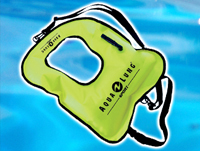 |
TOP
HOME | 







